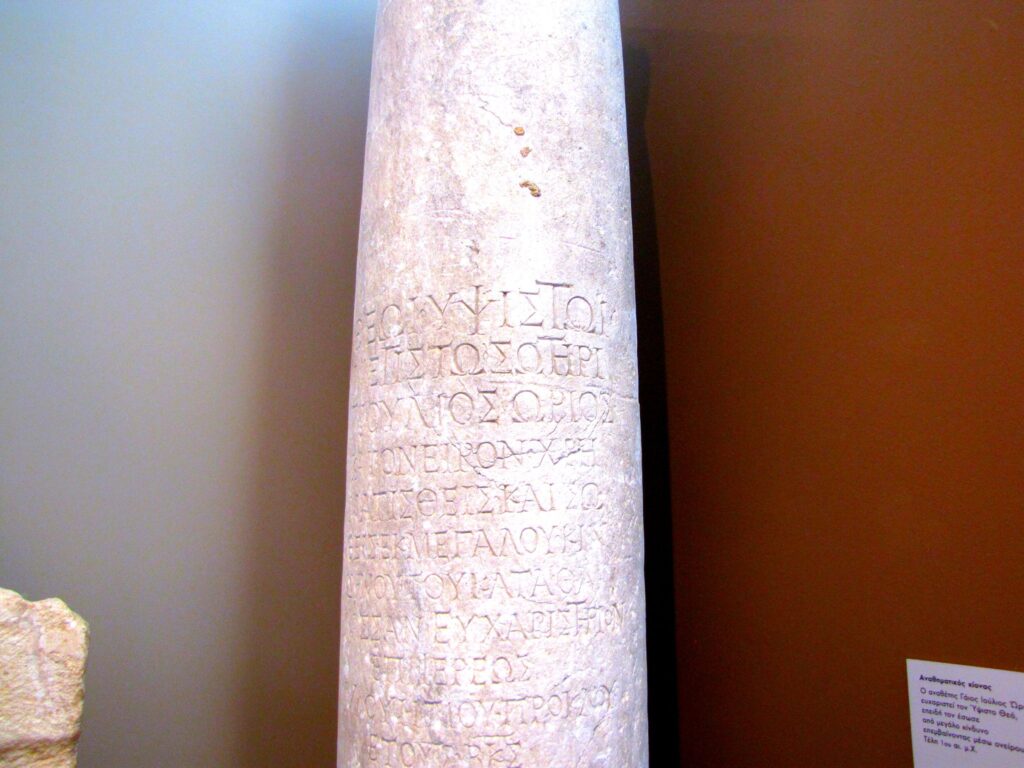The main theme at the Archeological Museum of Thessaloniki, Greece is classical history. Here we can see artifacts from the city of Thessaloniki, the area around it, and also the unit of the gold.
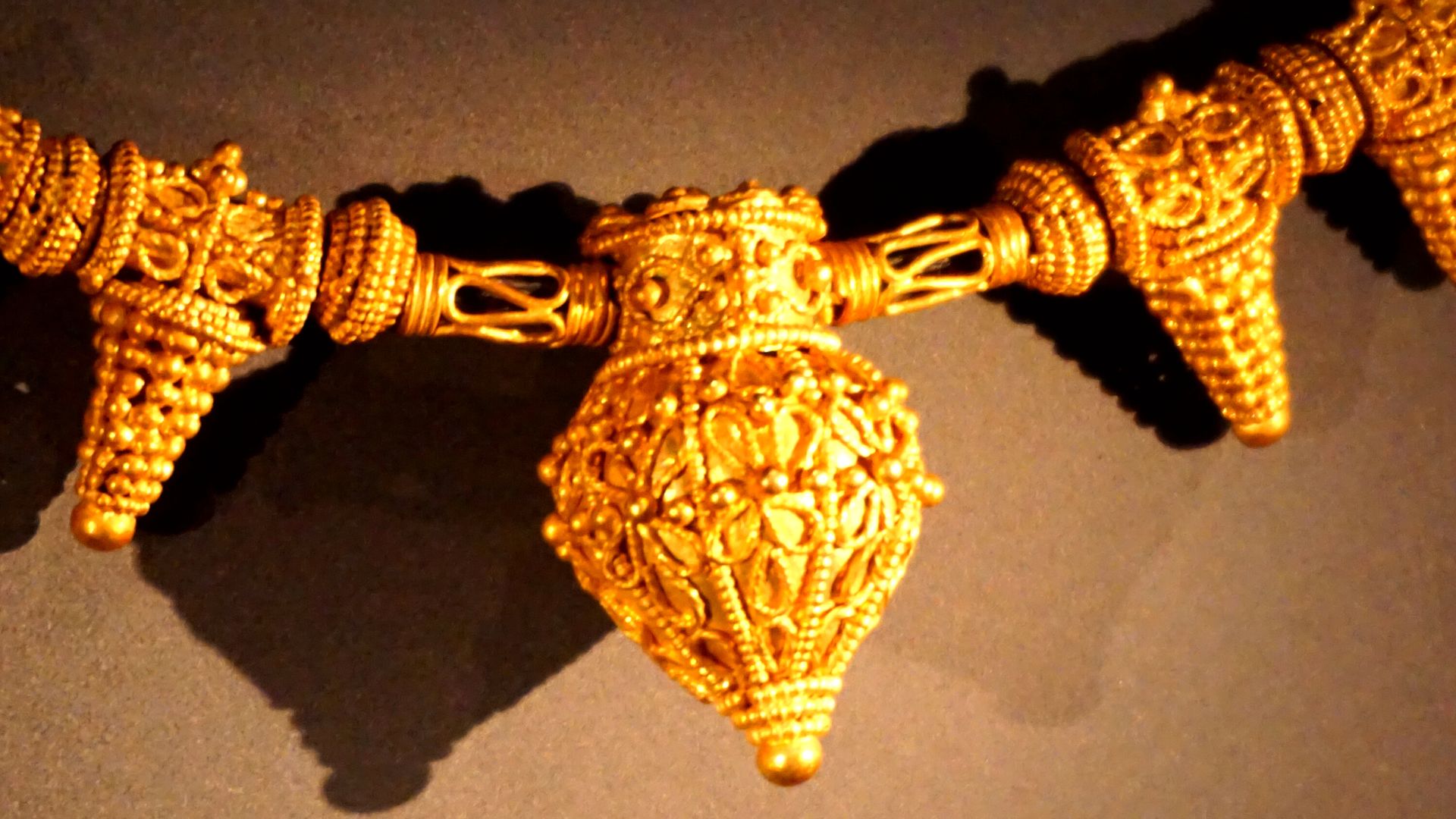
You see the granulation, the little spheres: today we can reproduce this jewelry, but only by using very modern equipment. How did these people, with their bare eyes, have the ability to make such small little spheres, all the same size, and put them all together in a special way to form the design.
Look there at these earrings. Try to see them carefully, to see the granulation technique. The granulation technique, the making of little spheres, appeared two times in ancient history – during the Mycenean time, and the time of the Trojan War. The granulation technique disappeared in the classical time, leaving behind unanswered questions.
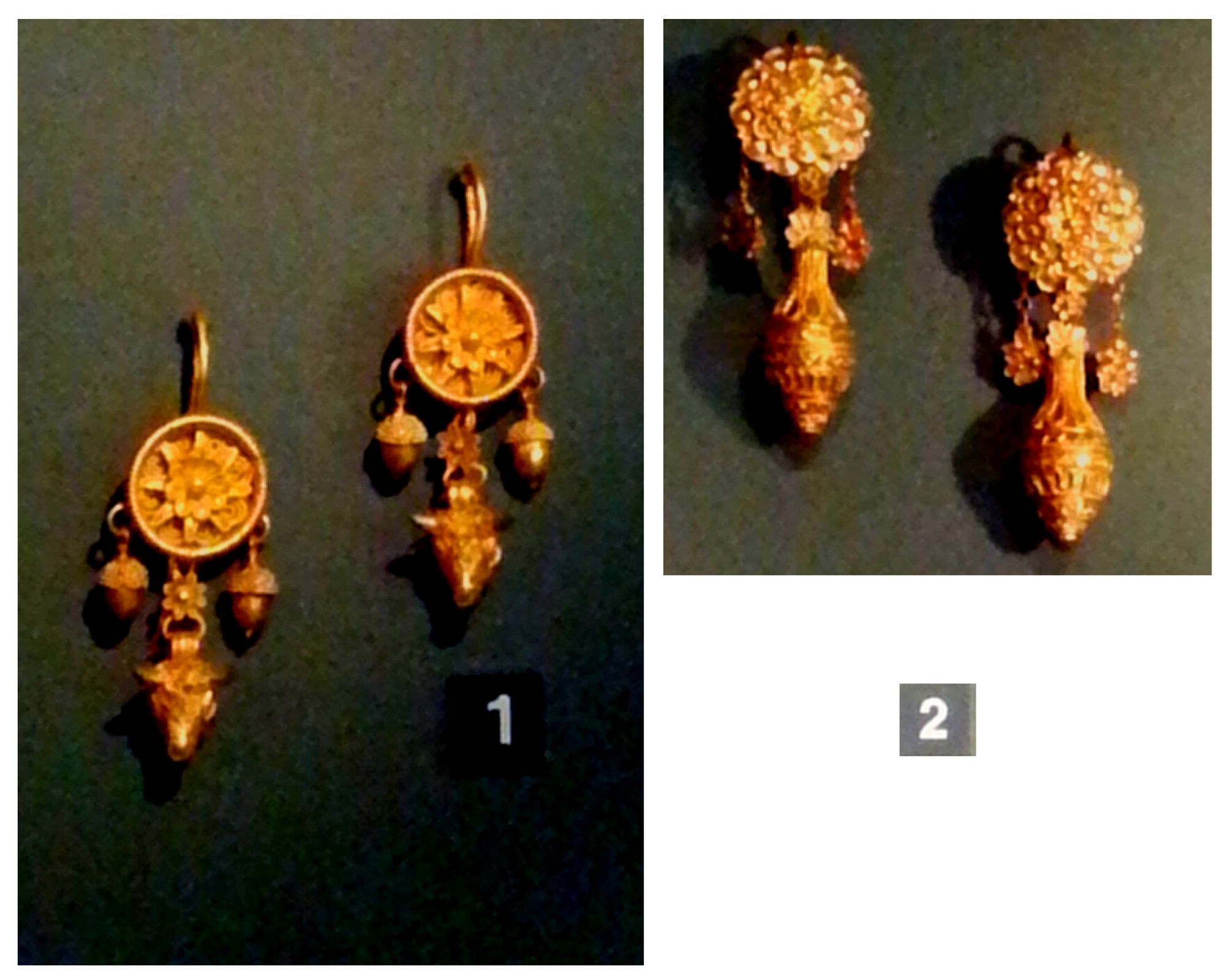
Ancient Greeks used a special vase called the crater. They used the word crater because of the volcanic mouth shape of this vase here. The name crater comes from the verb for mixing things inside.
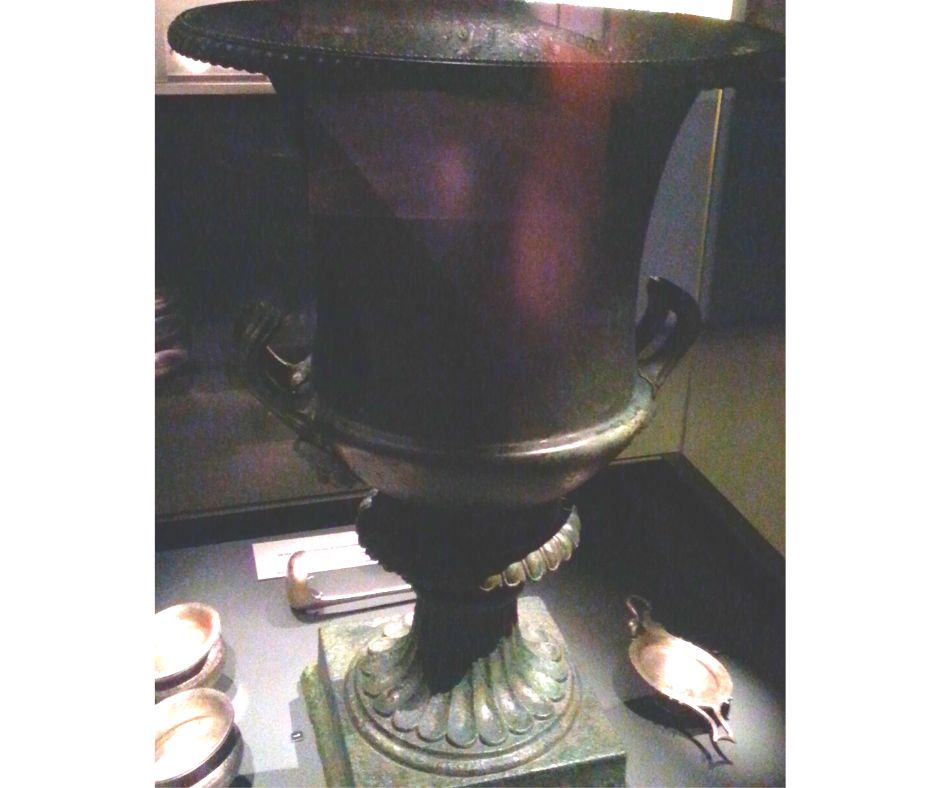

To purify their drinking water Greeks put three parts water and one part wine inside their cup. Here you see a crater with three silver wine cups:
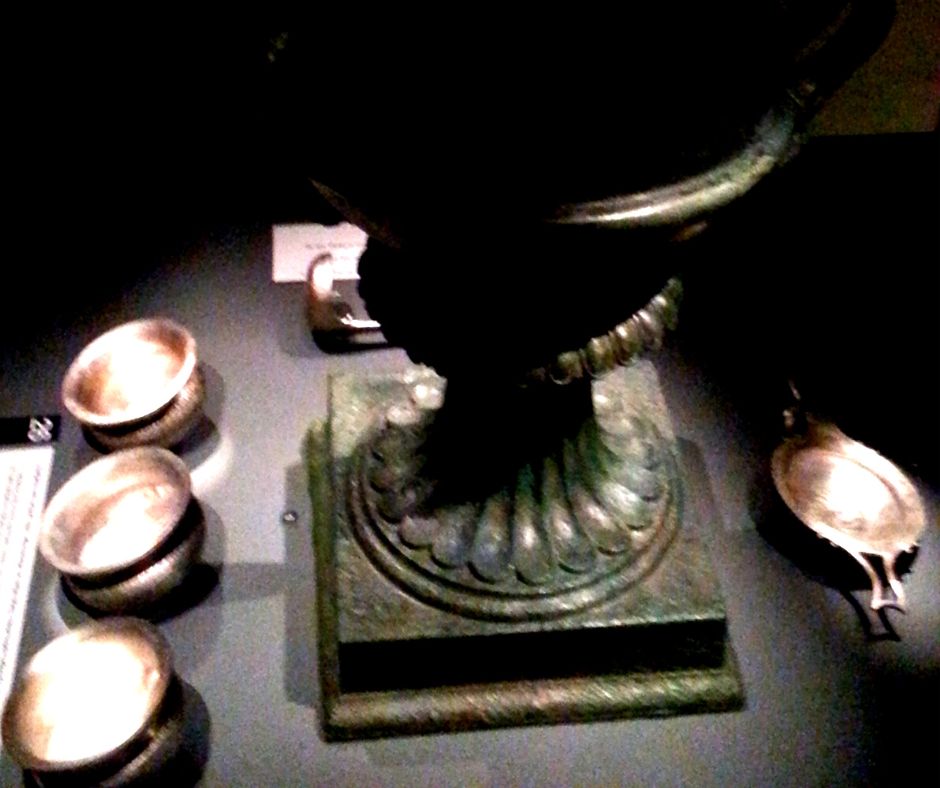
In antiquity the wine cups had broad mouths, so that they could enjoy the smell of the wine when drinking it. But also, in the bottom of the cup they put, a portrait of the beloved person. So, they could enjoy, all at the same time, the taste and the smell of the wine and the sight of their beloved.
And this is what you see here:
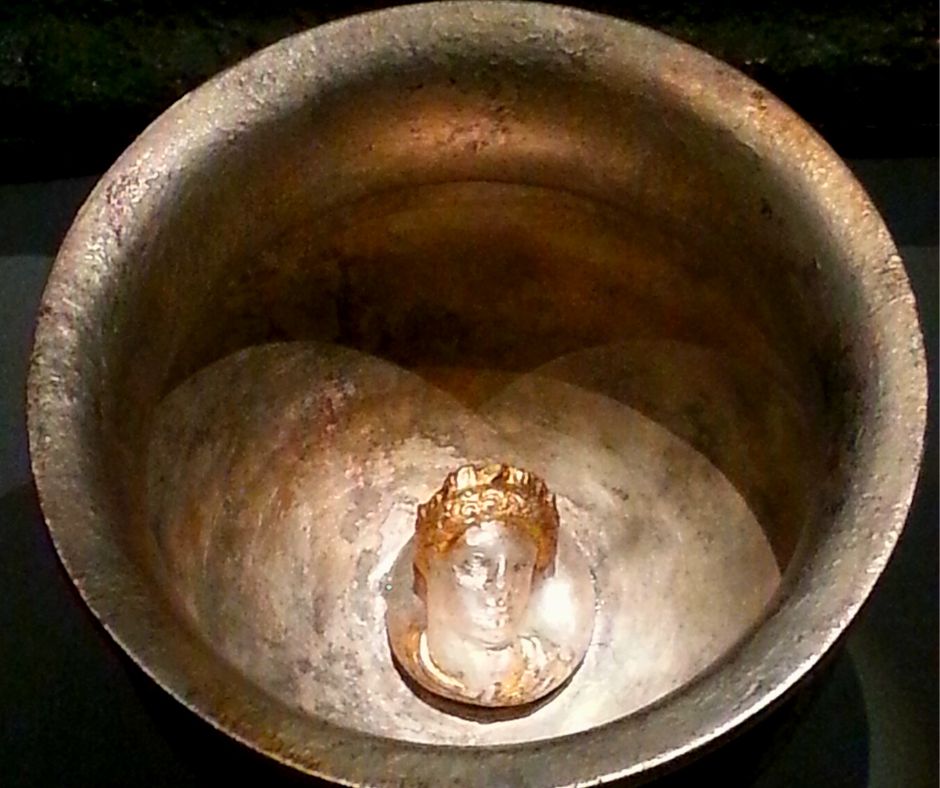
Even today Greeks have a proverb they say if they want to price the “smartness” of somebody: “This person is to be drunk in a cup of wine.” This is a proverb that is still used in Greece today.
We have here the decoration of a wooden box, a silver wine cap, and the decoration of the upper part of a leather breastplate with metallic parts and another myrtle wreath.
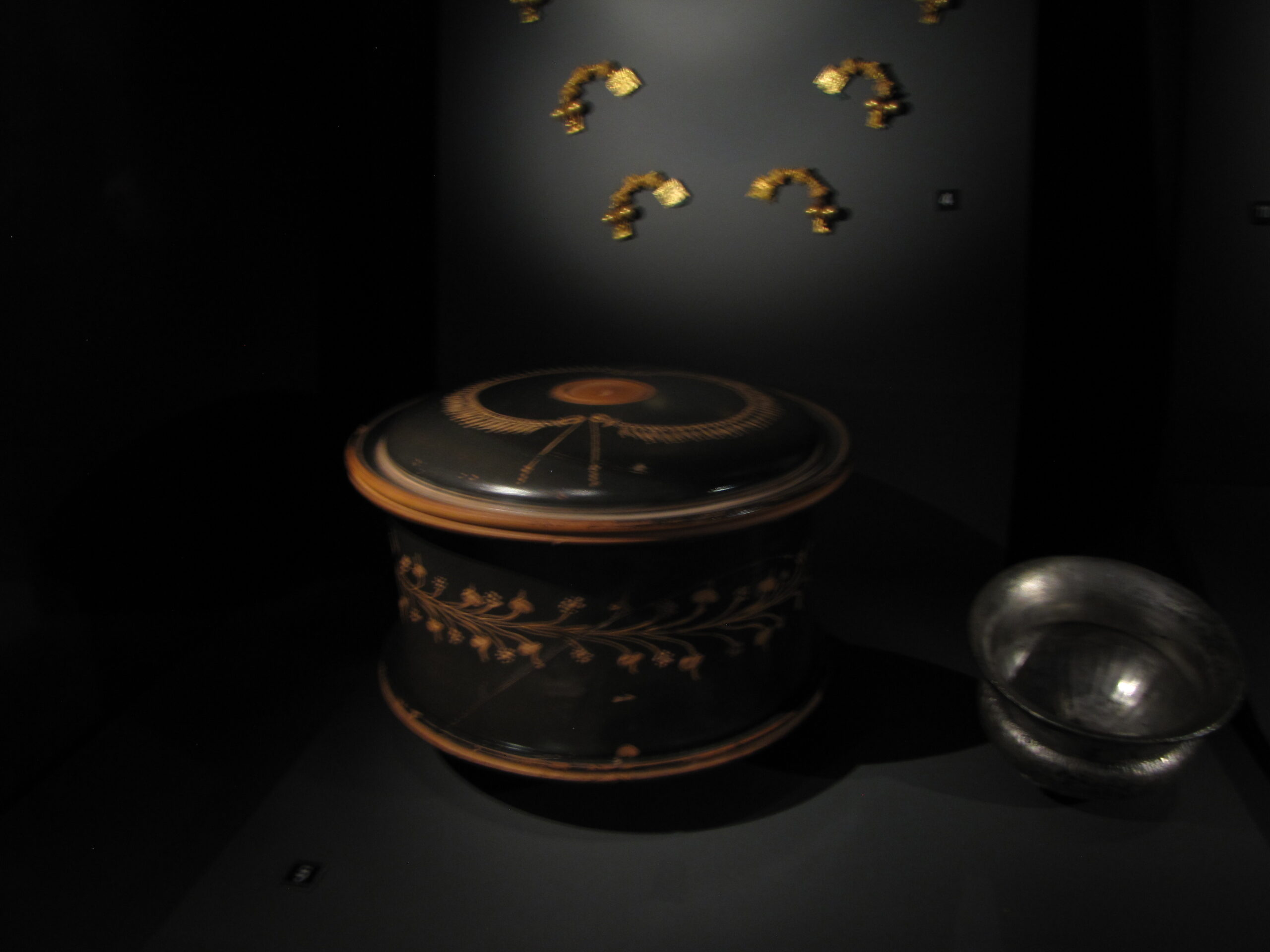
Look that myrtle wreath here. Sometimes, yes when you are close, and you speak, you see the little things moving. The vibration can move it. I do not know if you see these flower there as I am speaking. Yes, it is very, very sophisticated, and delicate.
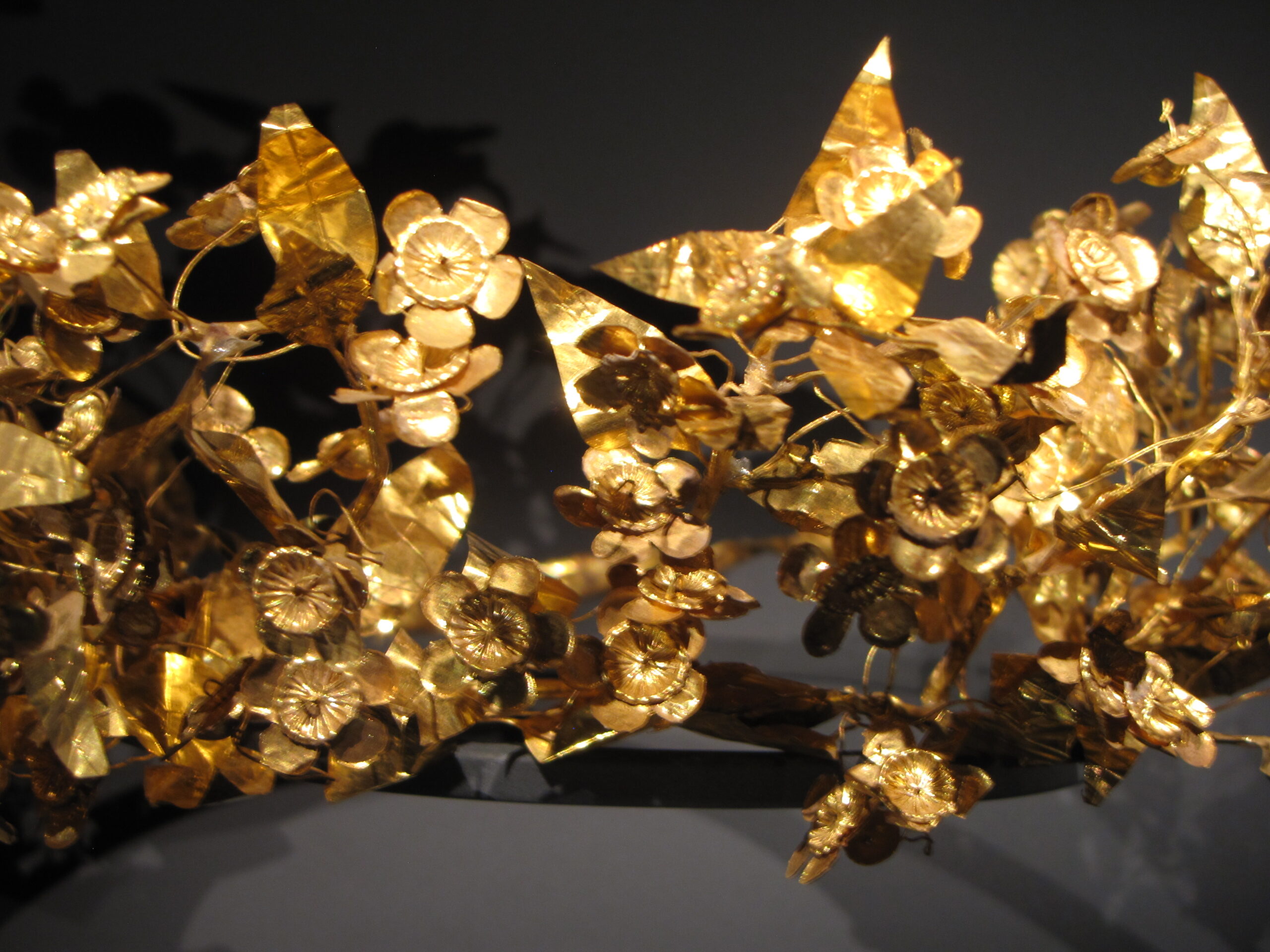
Government themes. Again, we have remains of a diadem.
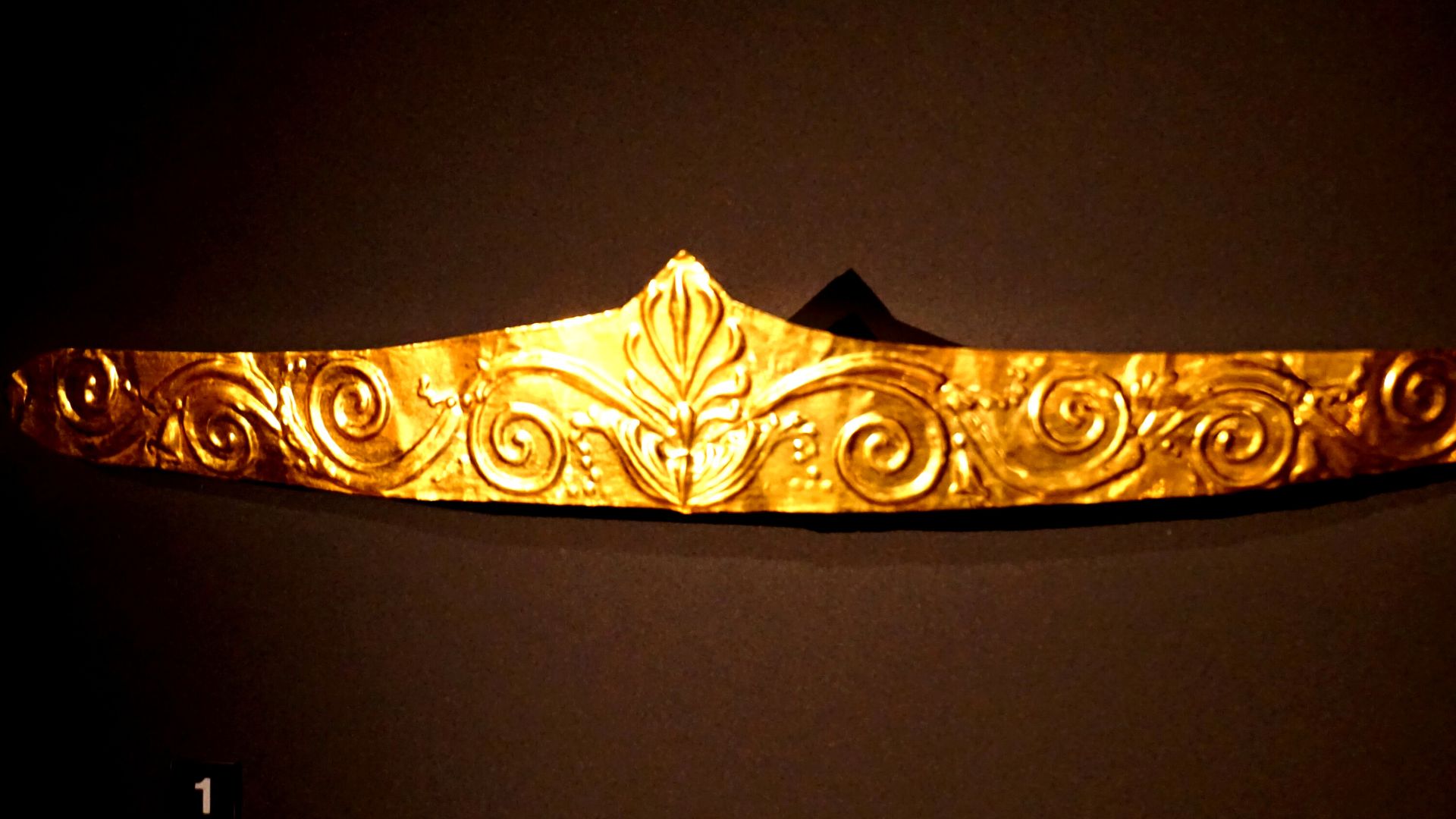
The decoration of the day – a ladies’ diadem, possibly a noble lady. Yes, the fashion from the Queen came to the nobility.
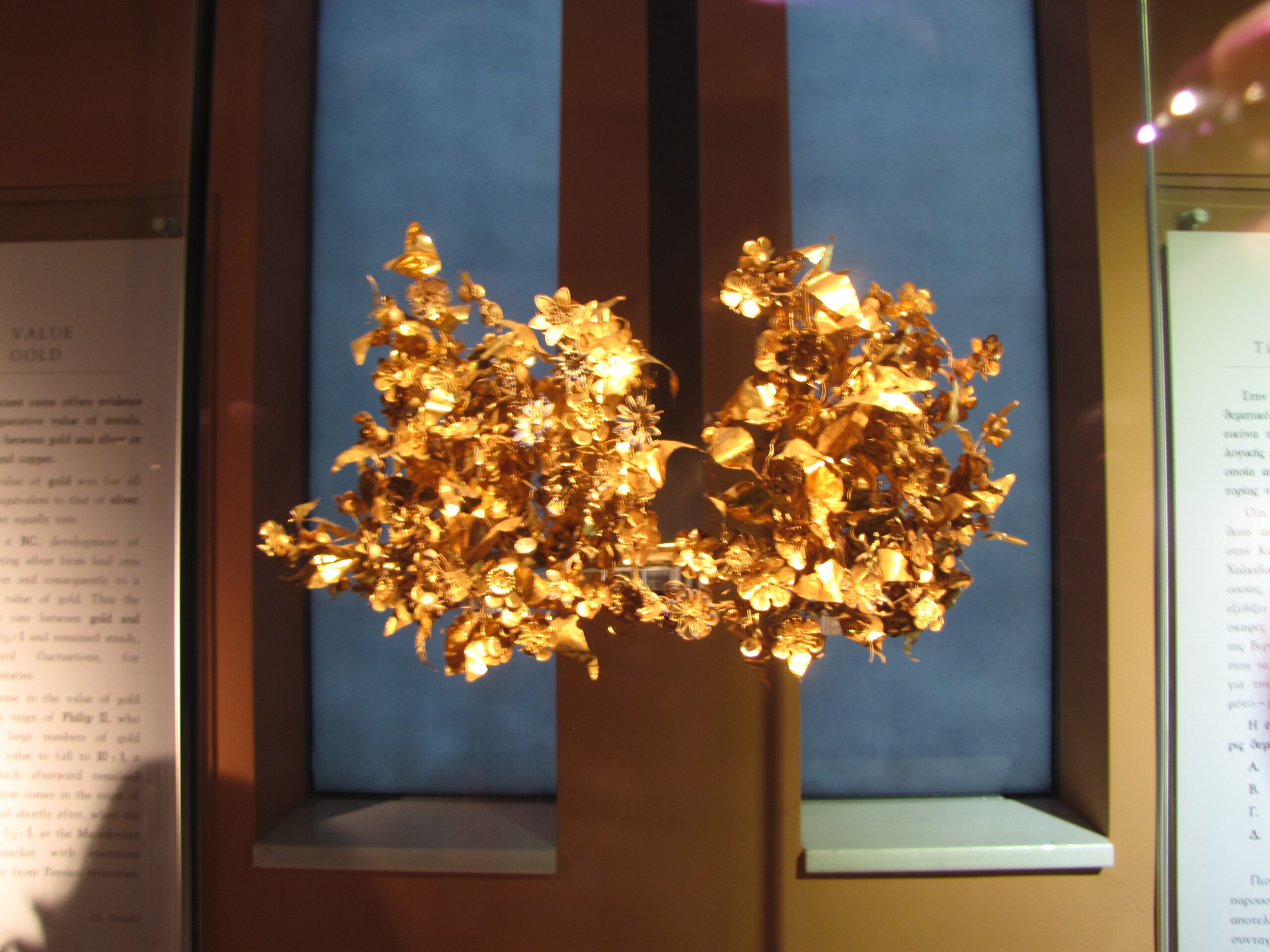
The ladies of antiquity also kept their little treasures, jewelry in cylindrical clay containers.
And remember, Second Corinthians 4:7, “But we have this treasure in jars of clay to show that this all-surpassing power is from God and not from us.”
Paul says we do have a treasure, which is Jesus Christ, kept in clay. Clay is called pyxis (πυξίς in Greek.) And still today, in the Catholic Church, pyx is the Greek name of the vase which keeps the blessed bread, the hostia, the body of Christ, the treasure. And pyxis is also the term used in medicine, the place for keeping the sterilized equipment inside. The pure the clean. pyx, pyxis – this is the jewelry box. This is what we are, with the treasure inside. The treasure inside is not jewelry, earrings, or necklaces but Jesus himself.
Let us take a little bit to these round pieces here. Can you guess what these are?
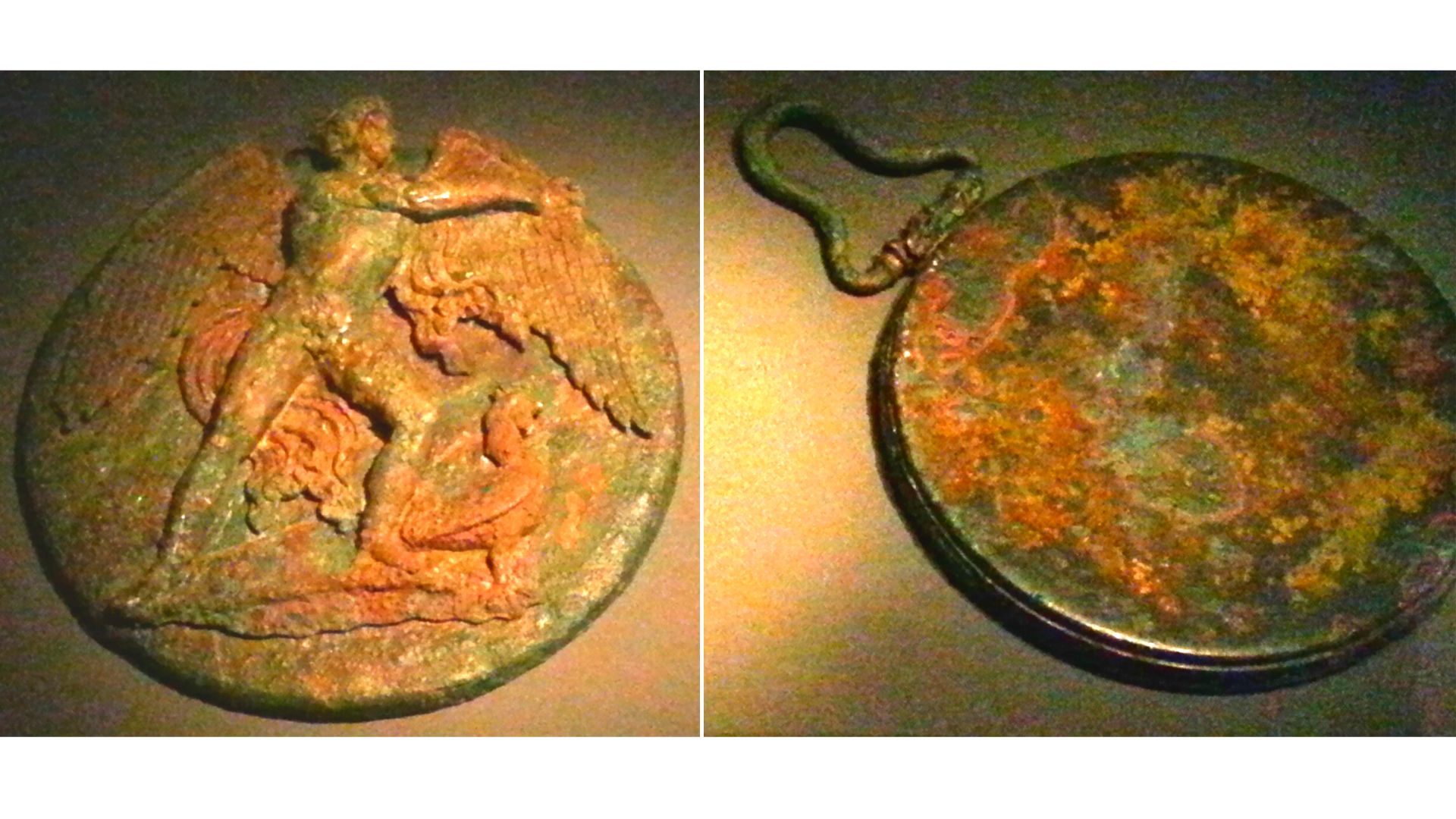
Could we use our Bible? Go to 1 Corinthians 13:12a. “For now, we see in a mirror, darkly; but then face to face.” Today, that verse has not any meaning for us, because we see our reflection in the mirror purely and clearly. At that time, the mirror that was used was a well-polished bronze face. And this is an ancient mirror in which they could not see color, except the color of the bronze and their face transformed to the degree this surface was leveled. You see the mirror and you see the cover of the mirror for its protection. So now seeing this mirror, this verse has a meaning… For now, we see in a mirror, darkly.
Here. This is an olive leaf. You saw that wreath there.
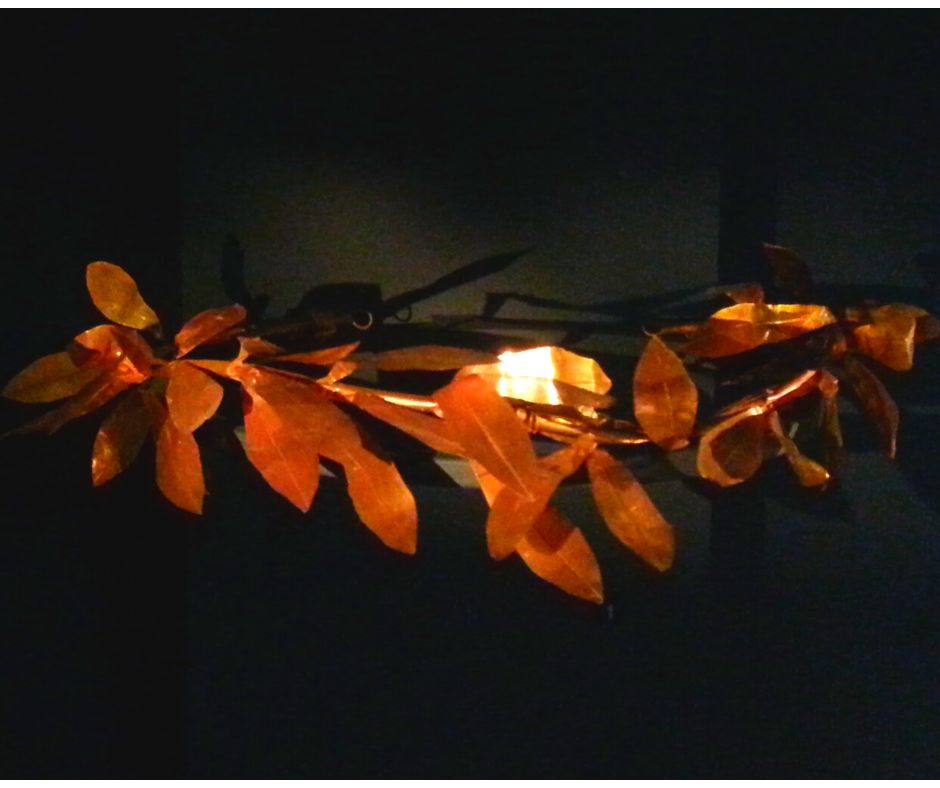
There is a wreath imitating ivy. Ivy is the sacred plant of Dionysus. Dionysus had two sacred plants, ivy, and grape.
We enter to a unit where something which made the archaeologists really surprised at the beginning. These items, when they were found, were considered to be gold. But they are not. This is Corinthian bronze.
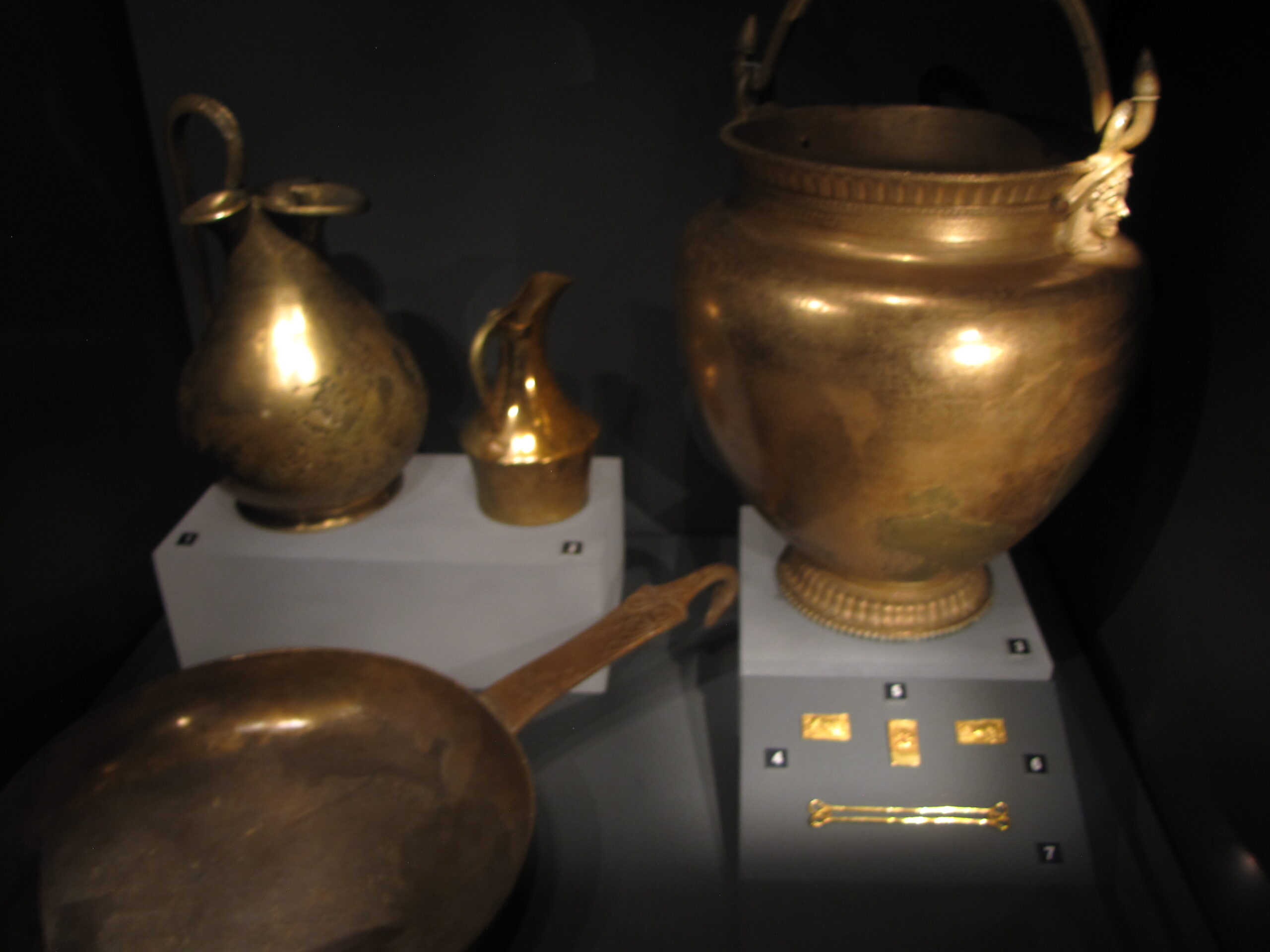
Flavius Josephus says that the two columns in both sides of Solomon’s temple gate were shining like gold made of Corinthian bronze.
Next, going to the Elysian Fields of Hades, in Greek mythology some enjoyed divine banquets with the gods. For that reason, always in the coffin, they put table silverware. Still today the Greeks put a jar, a cup, in the coffin. This tradition, from generation to generation, is preserved because in the Greek culture, we do not have the belief in gaps of nonexistence. The Greek culture, or the Greek language, have never considered a gap of nonexistence.
Here we have a bowl, a phiale. The indentation in the center helps hold the bowl while drinking or pouring from it.
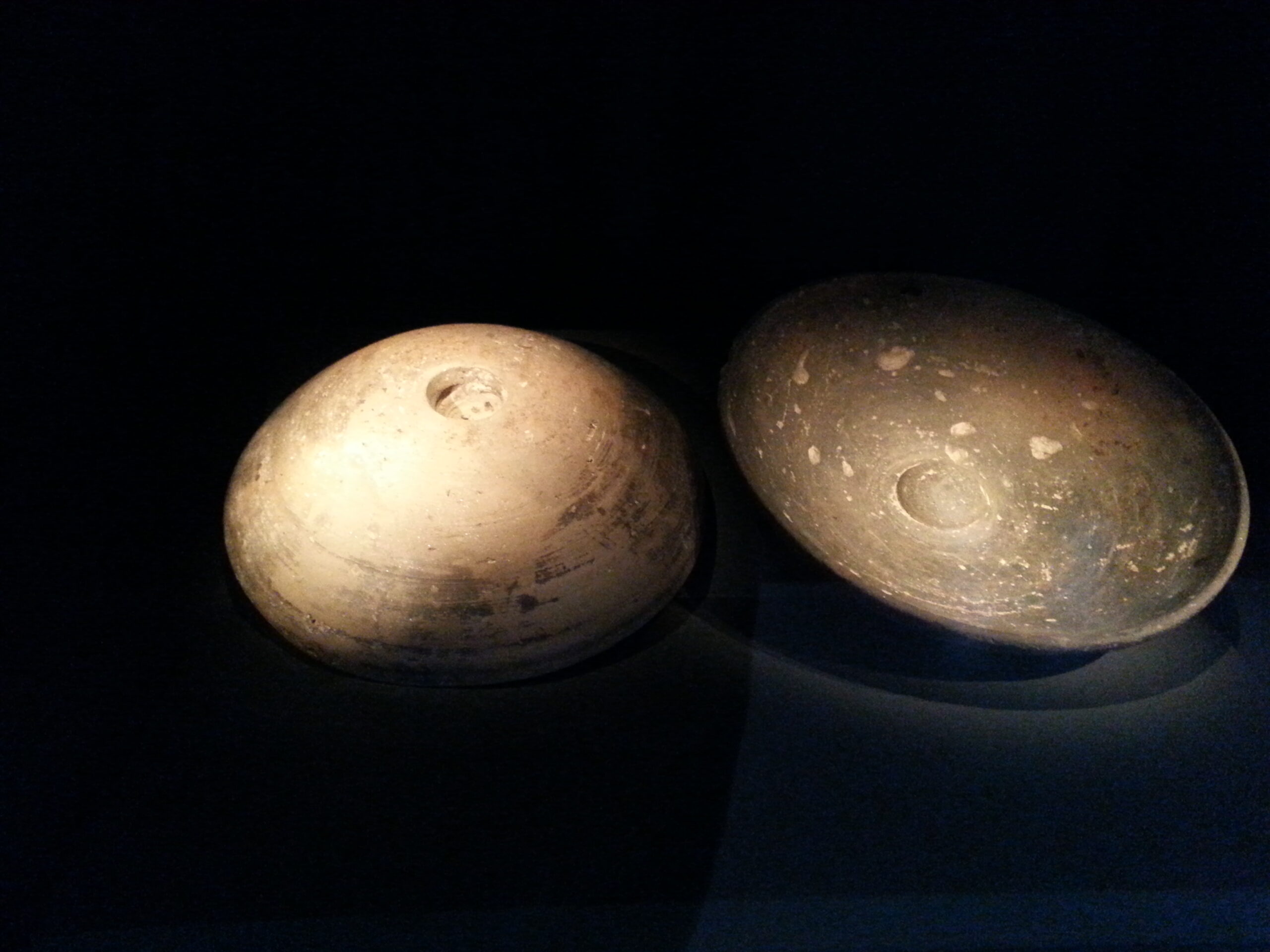
From the Iliad Book 3, line 292: “Then they drew wine from the bowl into the cups, and poured it forth, and made prayer to the gods that are forever. And thus, would one of the Achaeans and Trojans say, “Zeus, most glorious, most great, and you other immortal gods…”
Libation (σπονδή) was poured out, accompanied by prayer, just before the crater of wine was served. With outstretched arms, or upholding the phiale in their right hand, they worshipped.
Paul wrote in Philippians 2:17, “But even if I am being poured out like a drink offering on the sacrifice and service coming from your faith, I am glad and rejoice with all of you.”
From John in Revelation 16:1 “Then I heard a loud voice from the temple saying to the seven angels, “Go, pour out the seven bowls of God’s wrath on the earth.”
Here are items from burials:
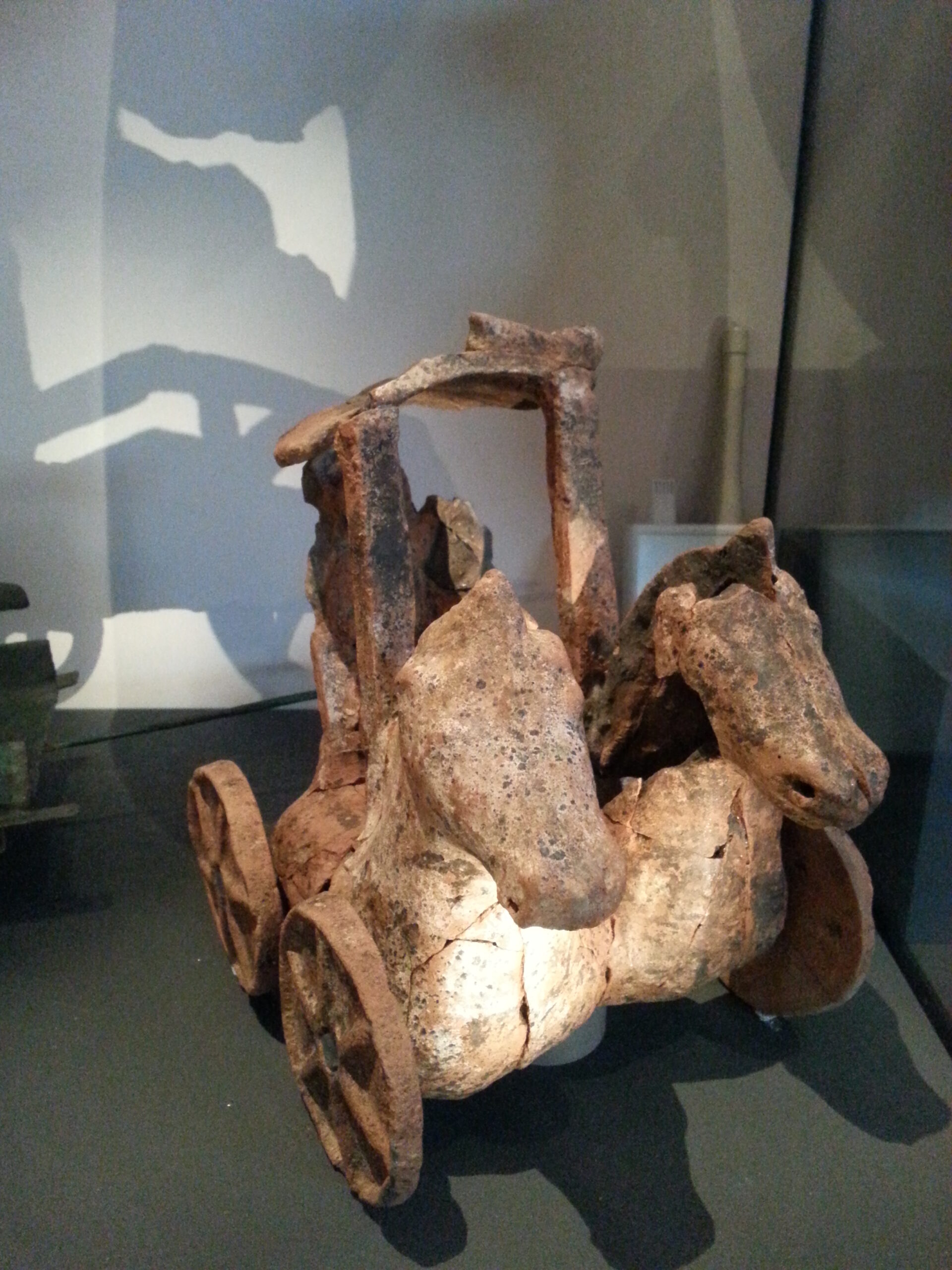


Sometimes if a lady died young and, especially, if not married (the same for a young man) she was dressed as if she were a bride (or a groom) so that she could continue married in the life down there. This is a tradition which still exists among the Greeks. So, if an unmarried lady, dies, they dress her like a bride in her coffin, not with a common dress, but with a bride’s dress.
Now we have a look at an honorary inscription where we can see these two words, ΟΙ ΠΟΝΤΑΡΧΑΙ, inscribed on the top of this large stone. ΟΙ ΠΟΝΤΑΡΧΑΙ means “the city officials”/”the local authorities.”


This is an decree by the city officials bestowing honor on the priest Apollonius of Kalamoto, Thssaloniki, Greece.
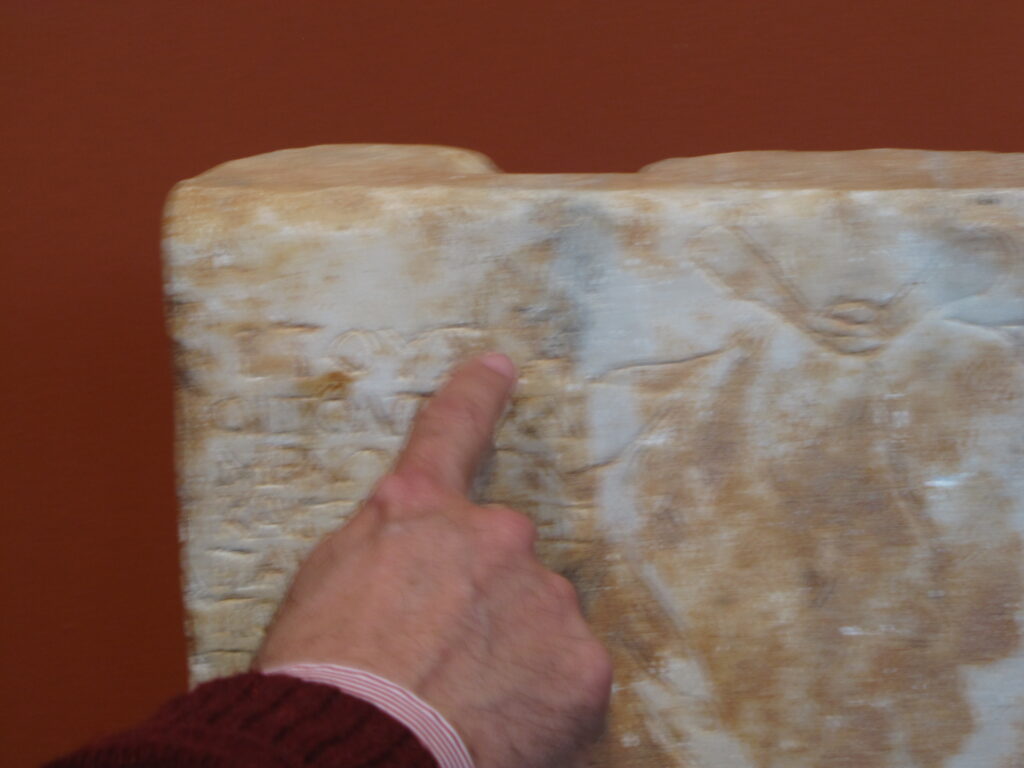



You can see the words ΟΙ ΠΟΝΤΑΡΧΑΙ meaning city officials. This term referring to city officials is also used in the New Testament book of Acts.
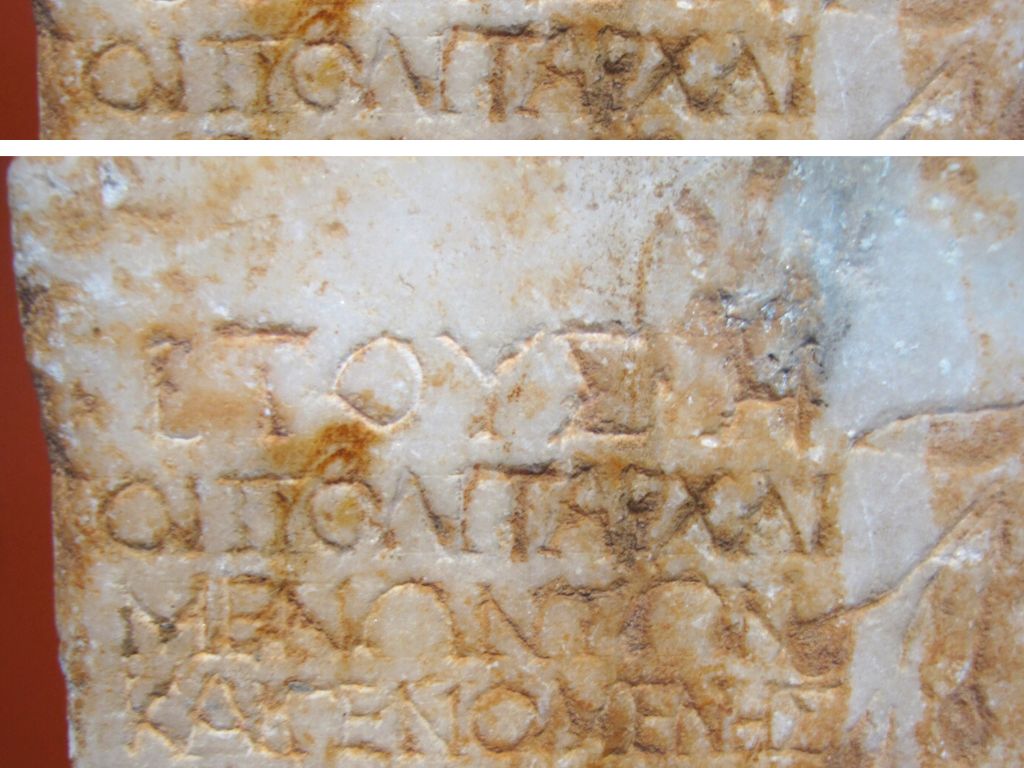
Acts: 17: 6b-8 “…they dragged Jason and some other believers before the city officials shouting: “These men who have caused trouble all over the world have now come here, 7 and Jason has welcomed them into his house. They are all defying Caesar’s decrees, saying that there is another king, one called Jesus.” 8 When they heard this, the crowd and the city officials were thrown into turmoil.”
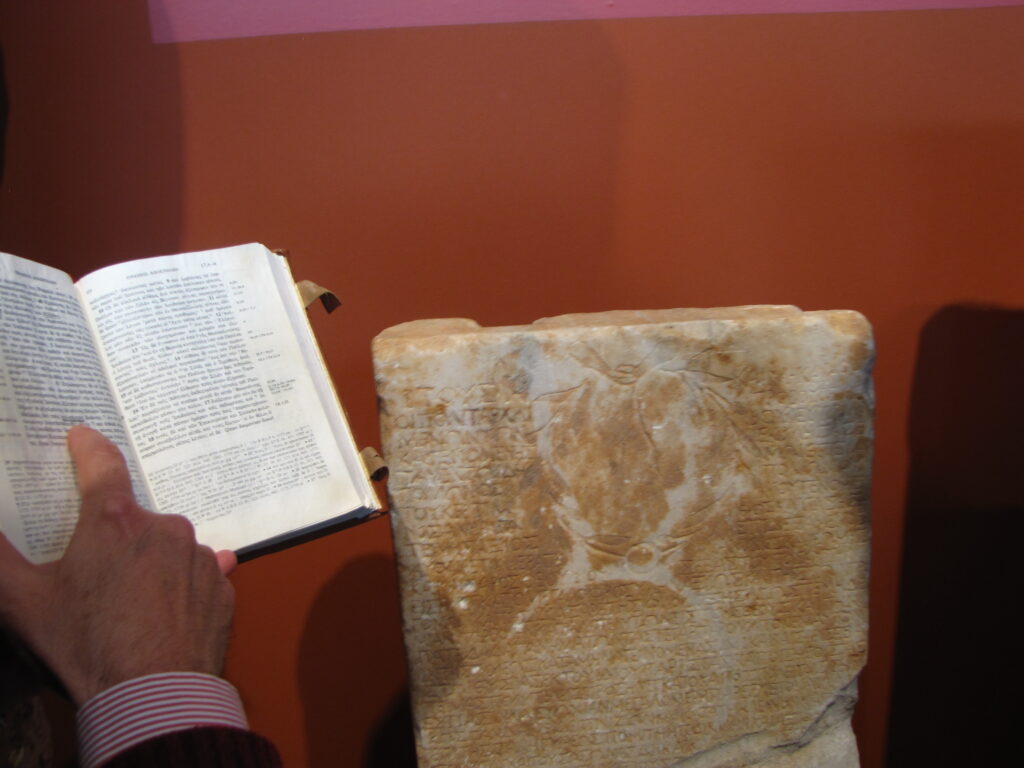
Next, we come to a special object. Look at these:
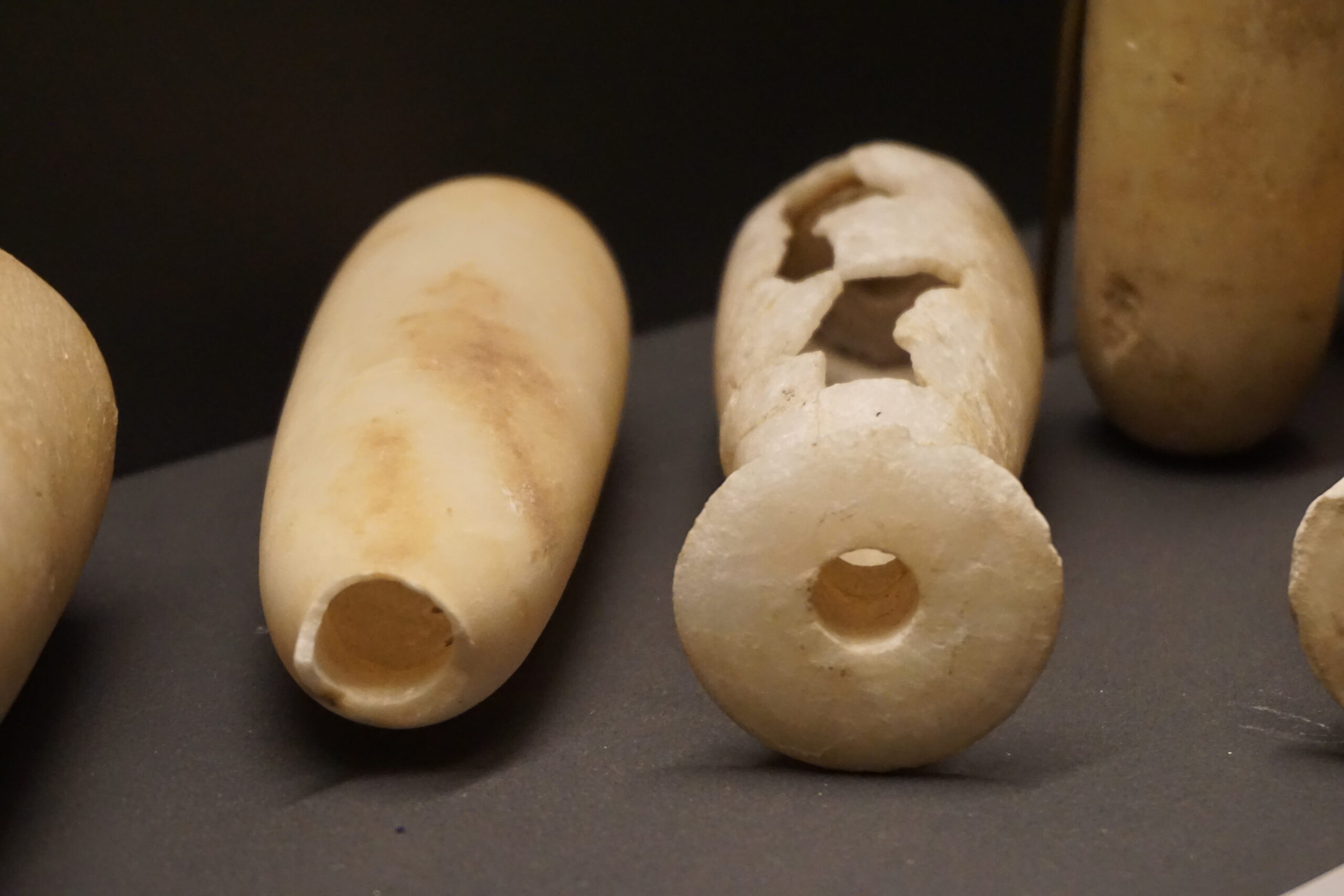
These are special objects, containers for perfumed oils, for myrrh sometimes. They are called alabaster because of their material, a kind of semitransparent marble chiseled inside and outside. Extremely expensive. Most of the time the containers were more expensive than the perfumed oil that were contained in them.
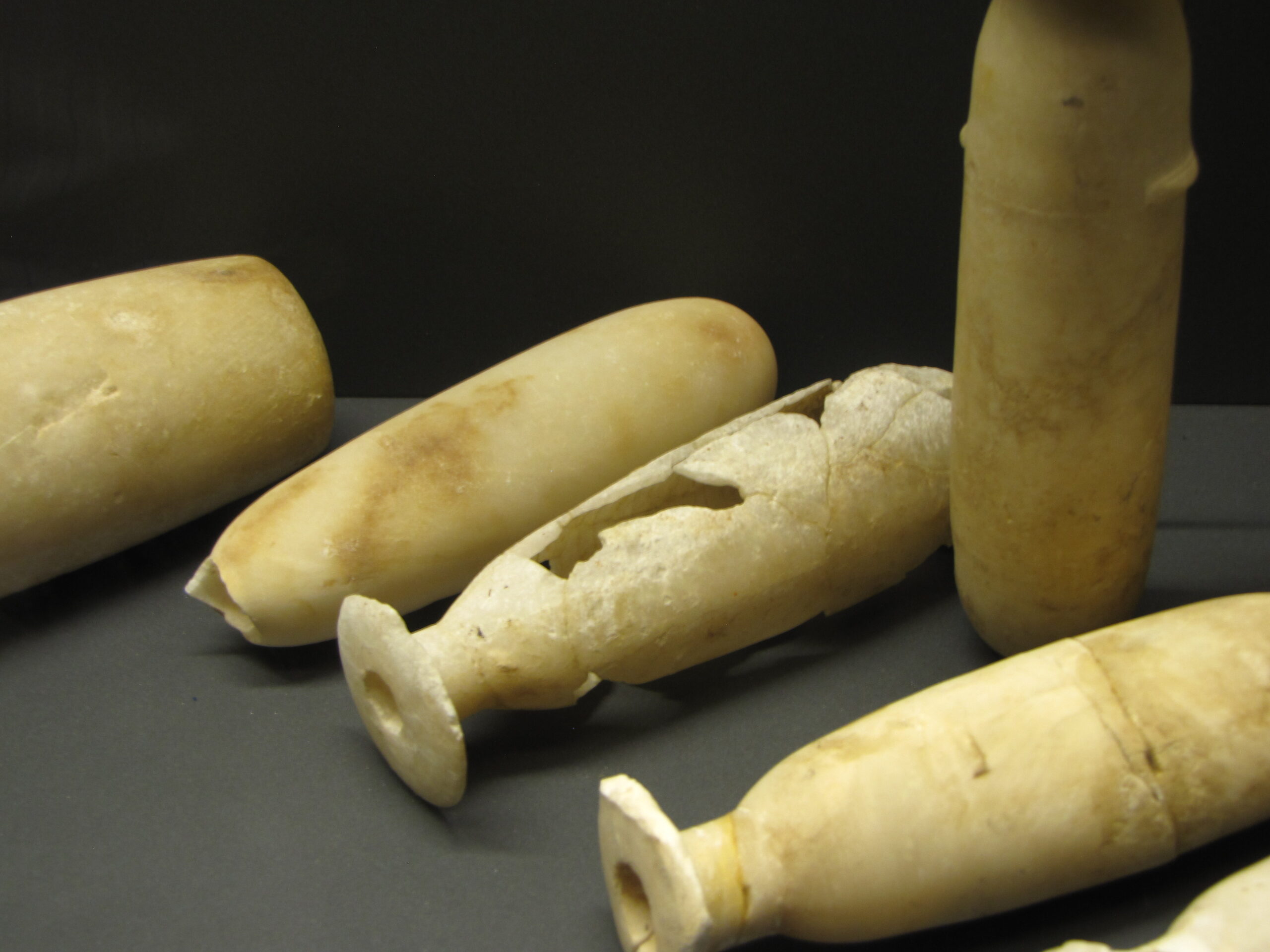
With the broken ones you can see how fragile and thin the shell was.
And if you would like to have an idea about what was broken by the lady at the feet of Jesus, this is it. And remember the reaction of Judas. Why so big a waste?
This is alabaster.
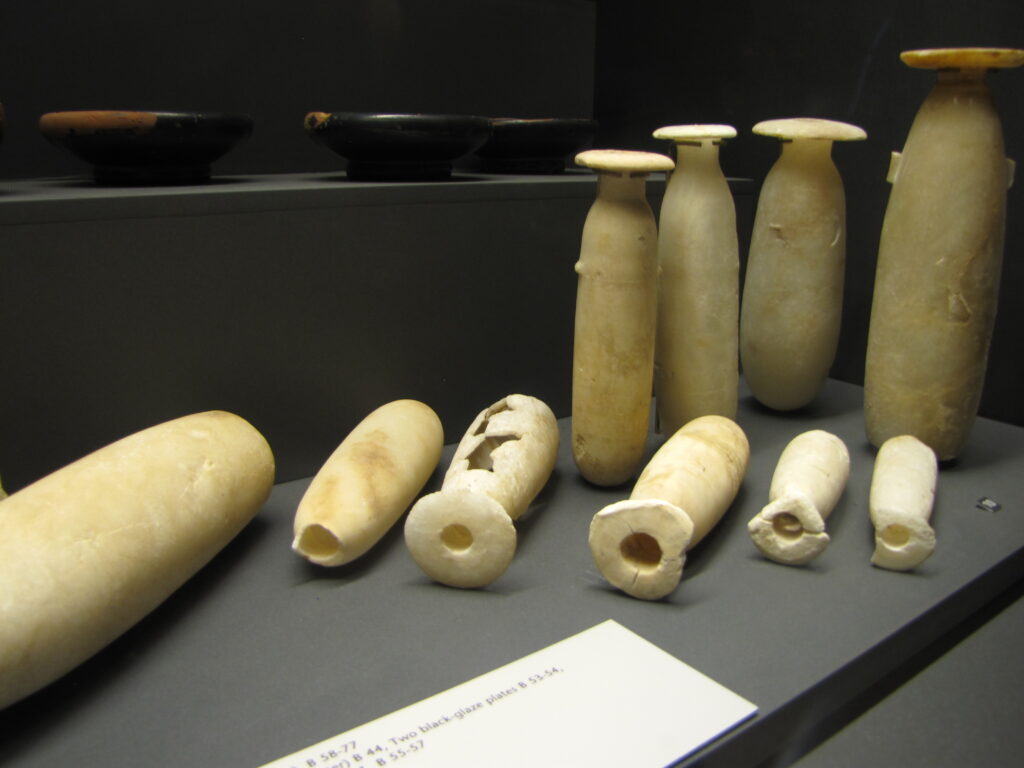
Mark 14:3-9 While Jesus was in Bethany, reclining at the table in the home of Simon the Leper, a woman came with an alabaster jar of very expensive perfume, made of pure nard. She broke the jar and poured the perfume on his head. 4 Some of those present were saying indignantly to one another, “Why this waste of perfume? 5 It could have been sold for more than a year’s wages and the money given to the poor.” And they rebuked her harshly.6 “Leave her alone,” said Jesus. “Why are you bothering her? She has done a beautiful thing to me. 7 The poor you will always have with you, and you can help them any time you want. But you will not always have me. 8 She did what she could. She poured perfume on my body beforehand to prepare for my burial. 9 Truly I tell you, wherever the gospel is preached throughout the world, what she has done will also be told, in memory of her.”
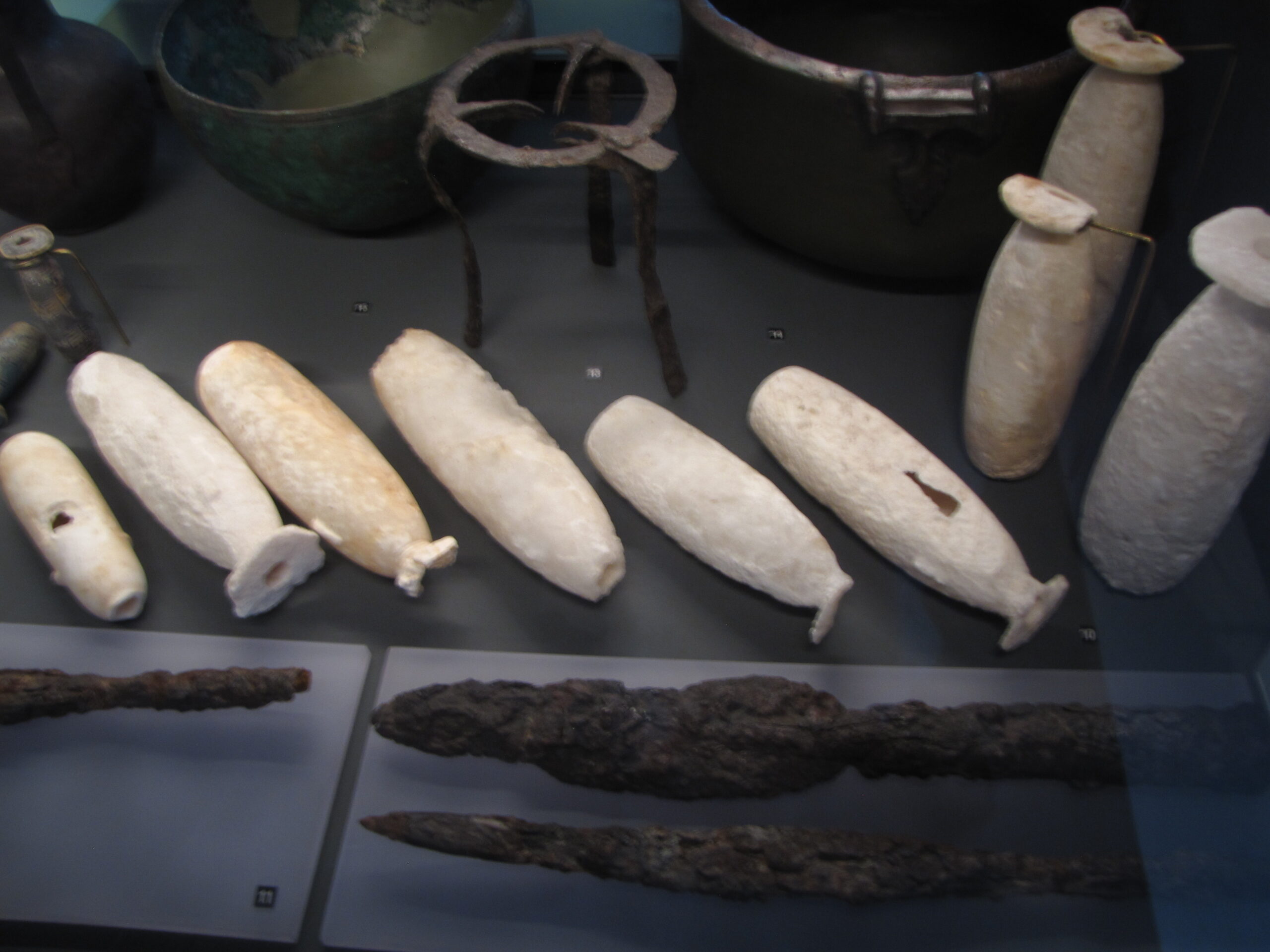
A chisel was an investment, and it was a part of the dowry sometimes. They had special chisels made of very precious medals. A chisel was passed down in families, received from the mother to the daughter. Yes: Ladies, escorted ladies. Be careful because there is not any room for mistakes!
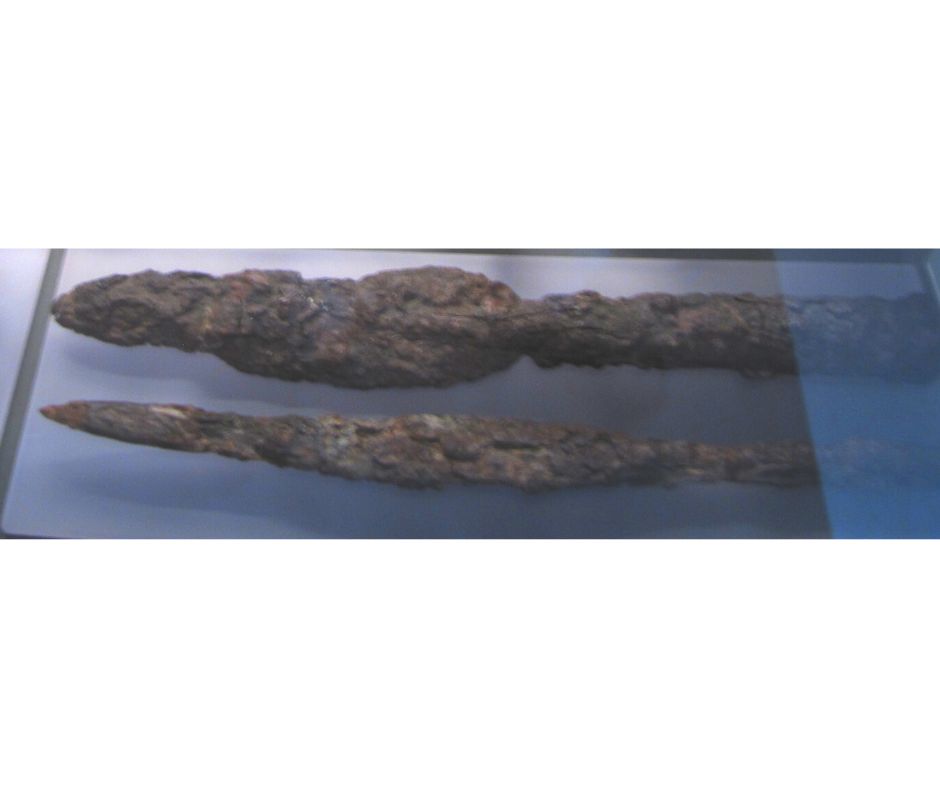
This is the Derveni crater, the crater that made a difference.
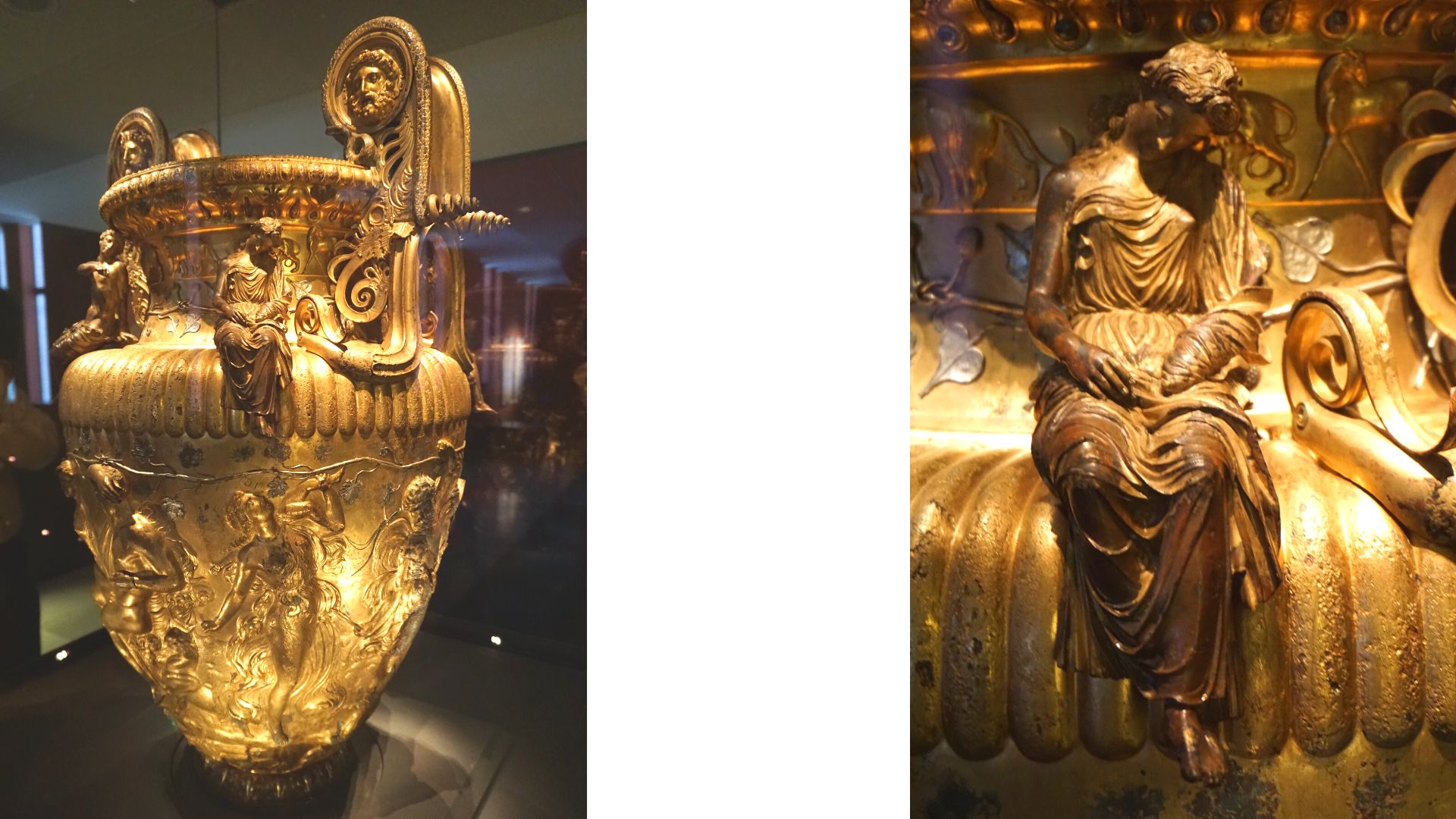

Finding this crater was the reason, after centuries and centuries, that Corinthian bronze was rediscovered.
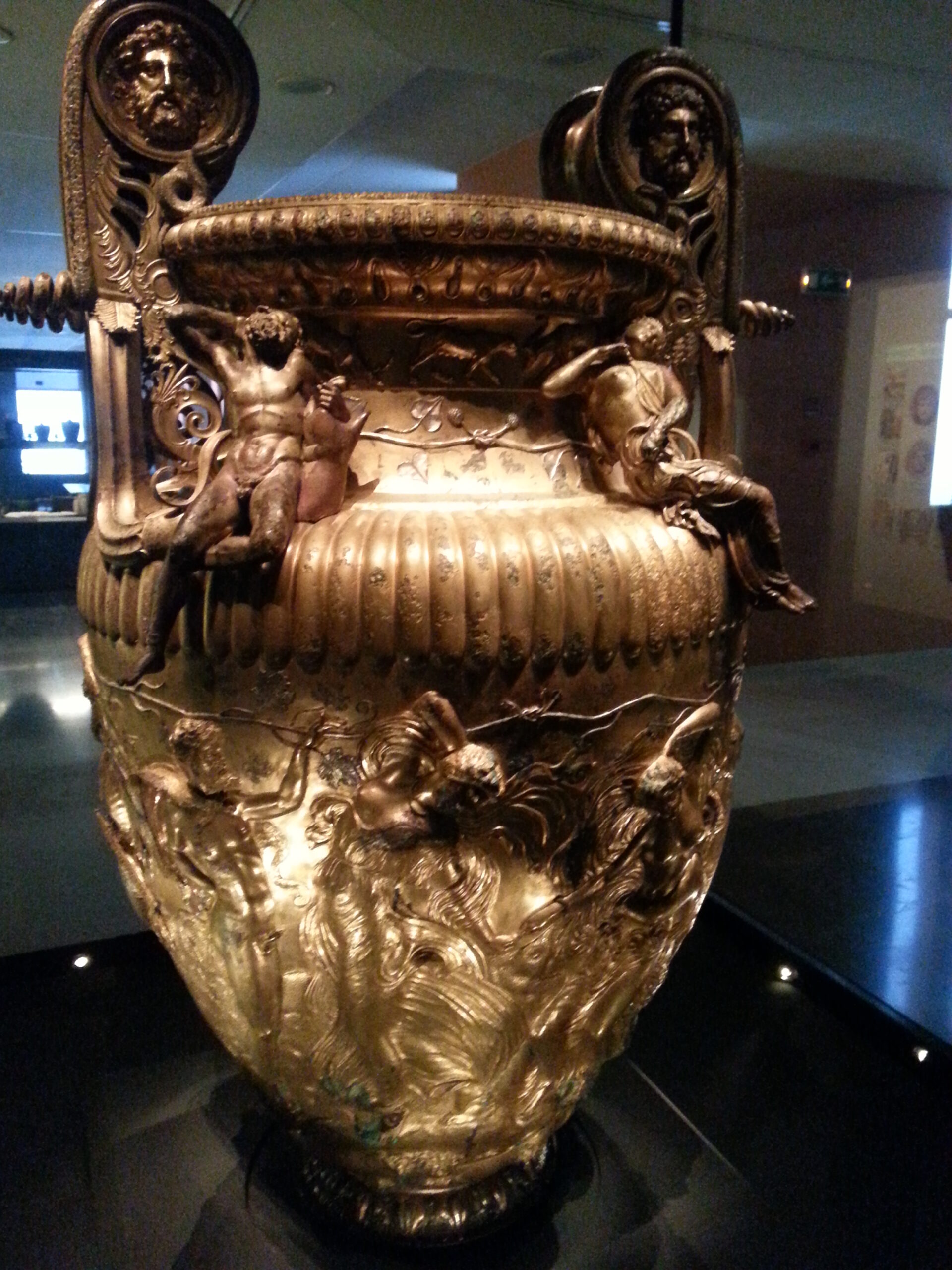
The Derveni crater goes back to fourth century BC, and it was used, in a second use, as a reliquary for the bones of a person, the ecologists think it was Alexander’s officer. It is brilliant, a unique piece of art.
Archaeologists thought it was made of gold, but they discovered there is not even one little gram of gold. It is Corinthian bronze. Their analysis brought to the light an extremely specific precision between copper and tin. At the beginning, they thought it was by chance. They could not understand how these people were able to count this percentage. But when they found more Corinthian bronze items in other places, they realized that these objects were created by purpose and not by chance.
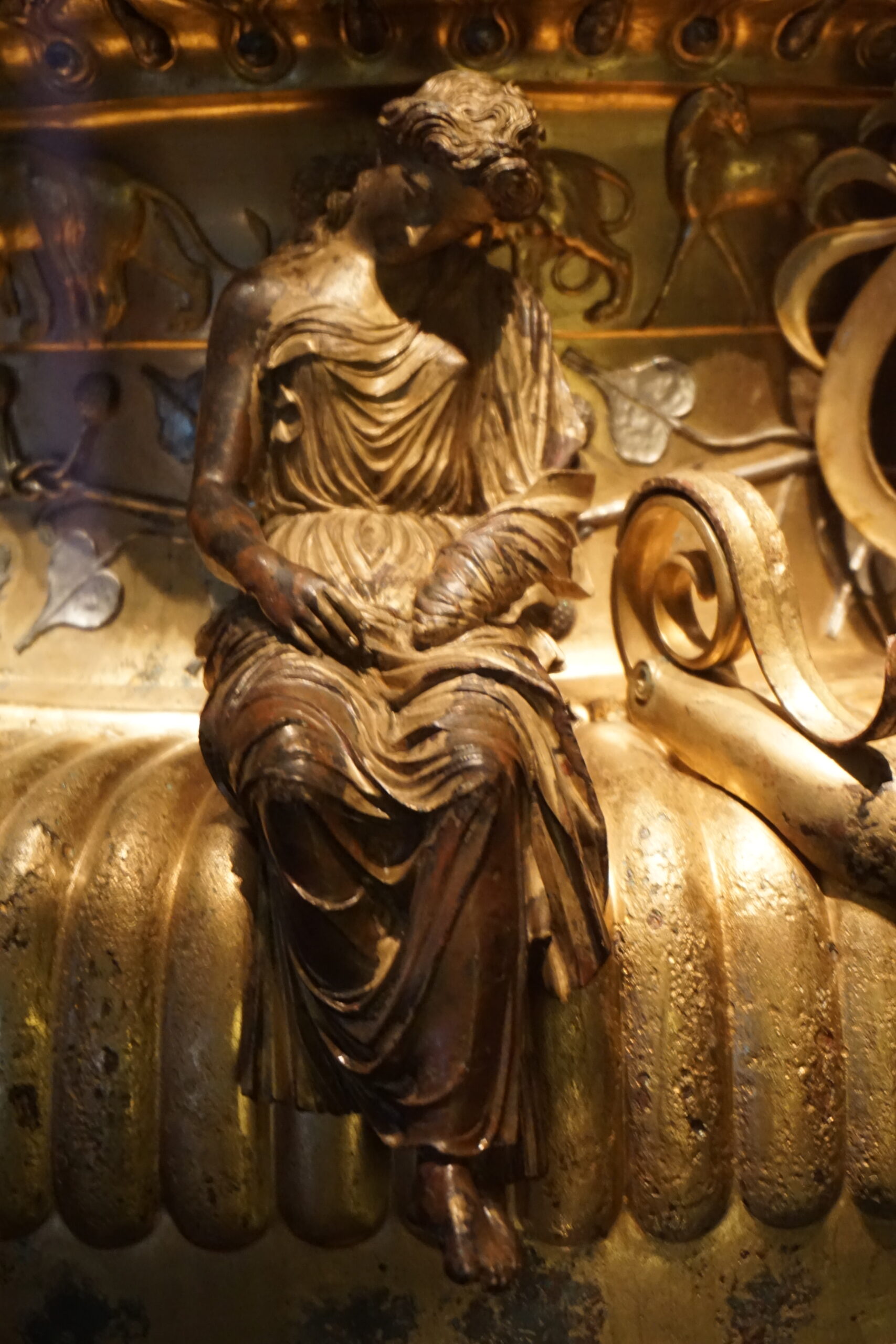
And this is how they transported the wine: these men drunk, holding the skin with the wine in it.
Matthew 9:16-17 “No one sews a patch of unshrunk cloth on an old garment, for the patch will pull away from the garment, making the tear worse. 17 Neither do people pour new wine into old wineskins. If they do, the skins will burst; the wine will run out and the wineskins will be ruined. No, they pour new wine into new wineskins, and both are preserved.”
You see the dancing, the orgies of Dionysus. You see drunk people. Here is dedicated to Dionysus worship. I would like you to see these drunk men here, they are holding a goat skin containing wine. And remember what Jesus said about new wine in new goat skins.
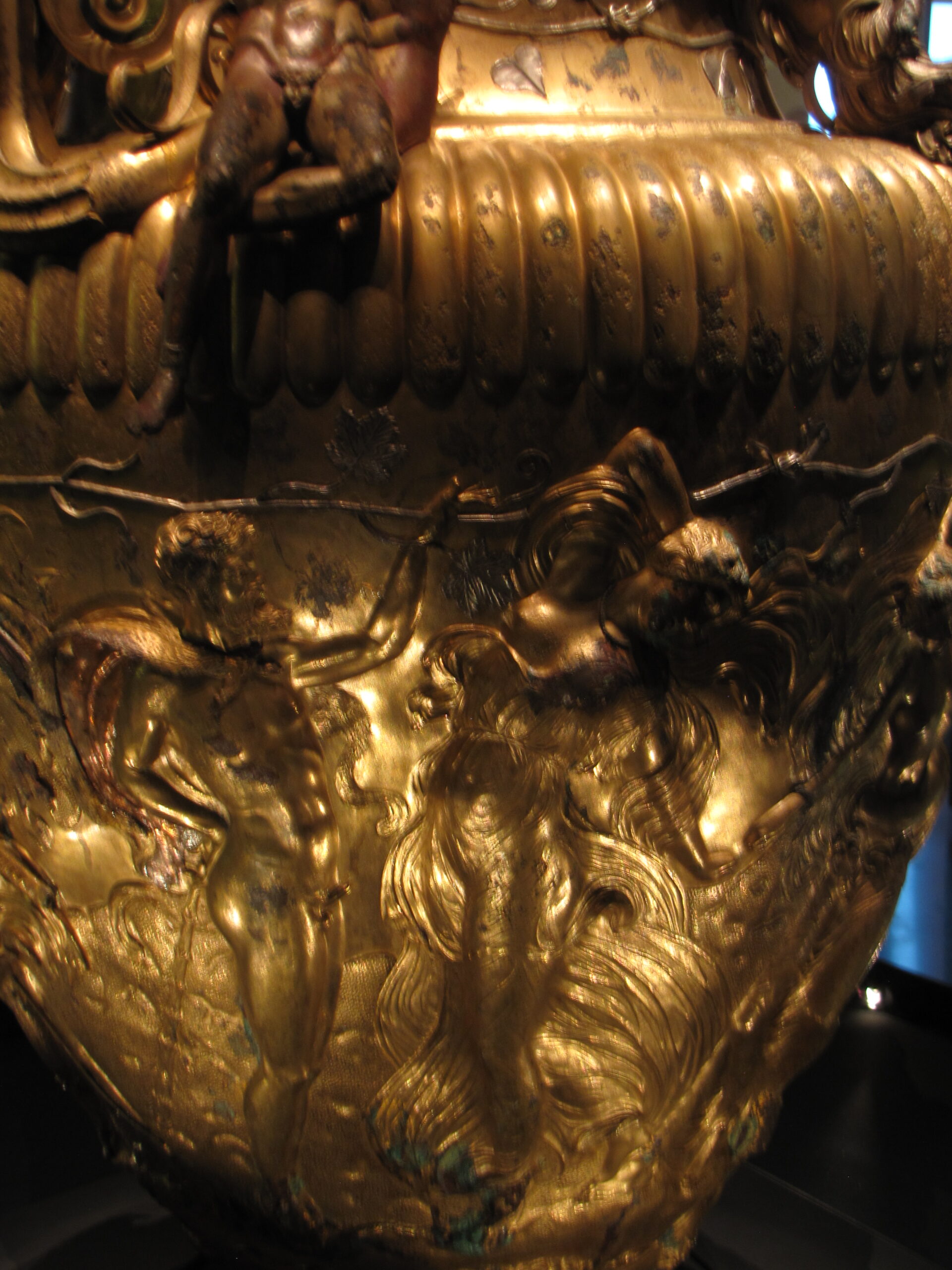
Corinthian Bronze was used in almost all of the first millennium BC, from the 10th century BC to the beginning of the first millennium after Christ.
Corinthian Bronze is related to the city of Corinth, Greece because it was in Corinth that they had the percentage of tin to copper used, the secret count, so precisely making this resulting imitatation of gold – without having any little grain of gold in it, and not tarnishing.
When Herod redecorated the Temple of Solomon, he put these kind of metal columns, two Corinthian Bronze columns, on both sides of the gate. We do not know if these columns were made with that secret in Jerusalem, or if they were ordered in Corinth and brought from Corinth to the Temple of Jerusalem.
Definitely Flavius Josephus says we are shining like gold, being golden because we are made of Corinthian bronze.
Expensive little item in this next picture?
Look here: Tin transformed an alabaster jar to look like the alabaster was covered with silver. Here is a fake, a cheap imitation, without a silver overlay.
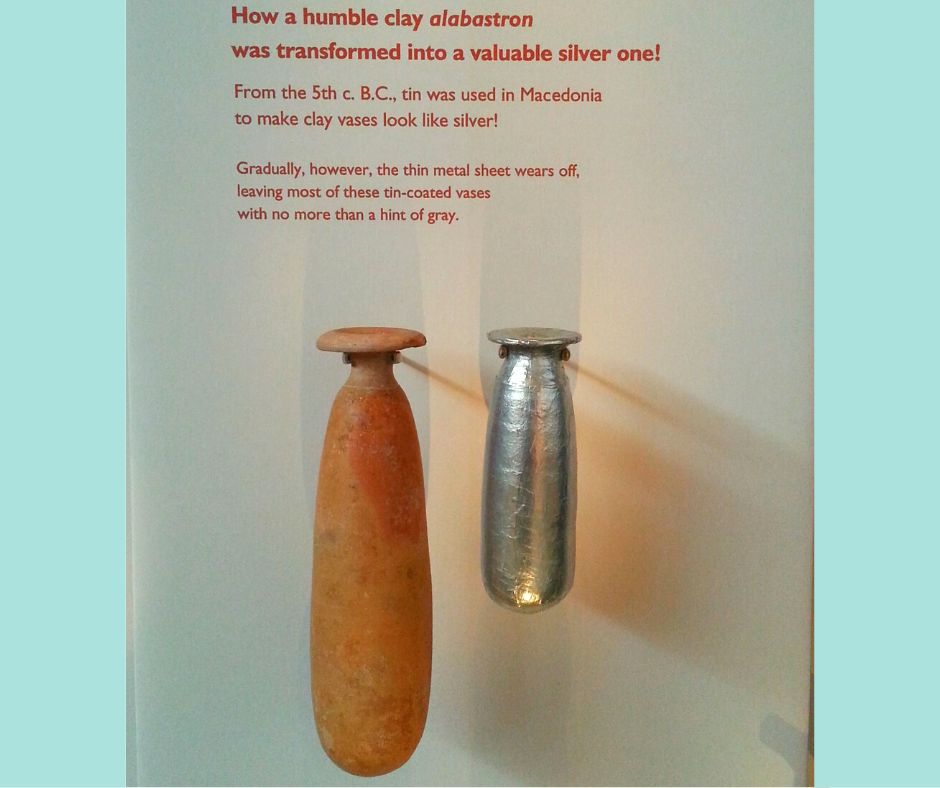
For archaeologists of today, their finishes on this item are made of terracotta, with glass outside. They imitate the alabaster originals.
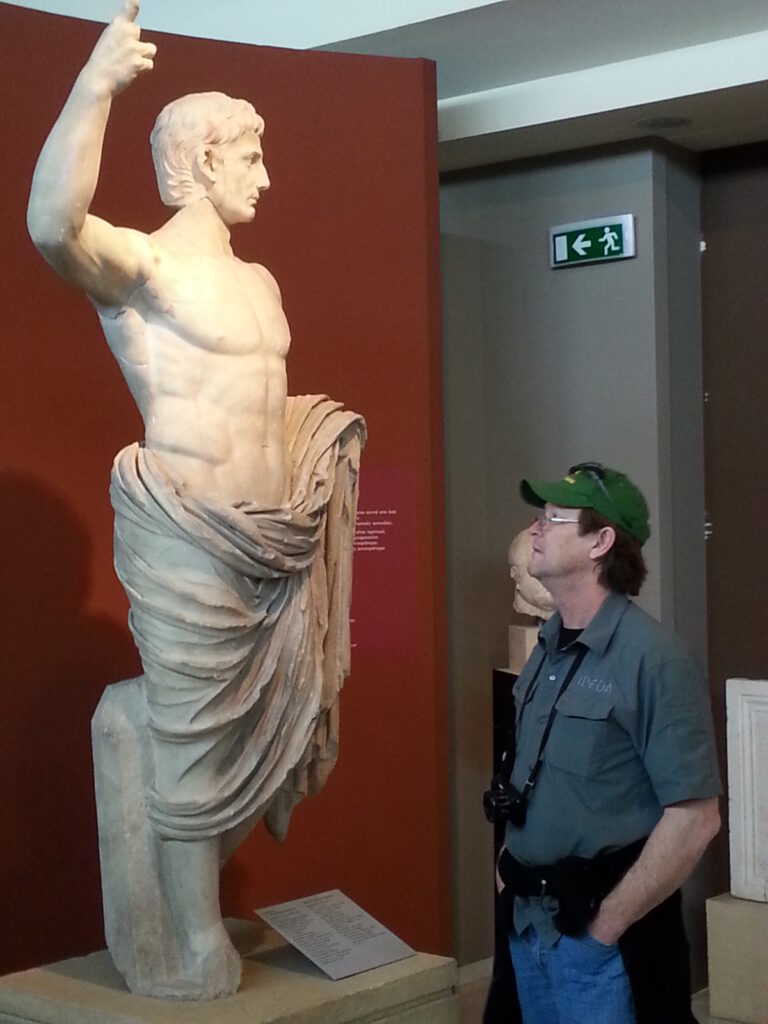




Colossians 2:15 refers to Jesus, the warrior ruler, “having stripped the principalities and the authorities, he made a shew of them openly — having triumphed over them in it.”
